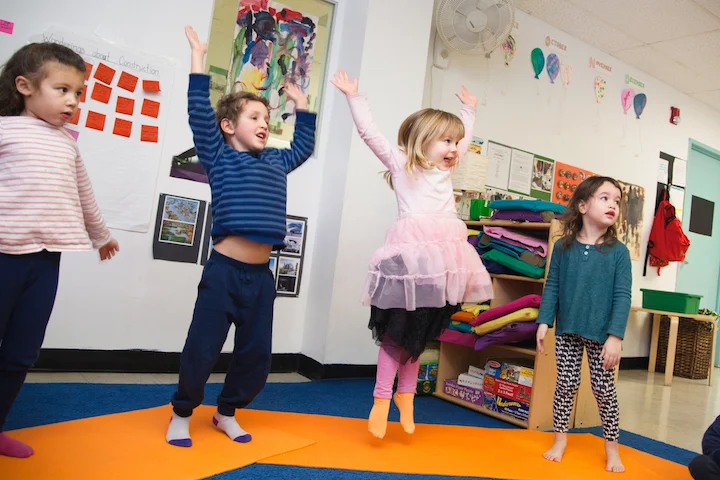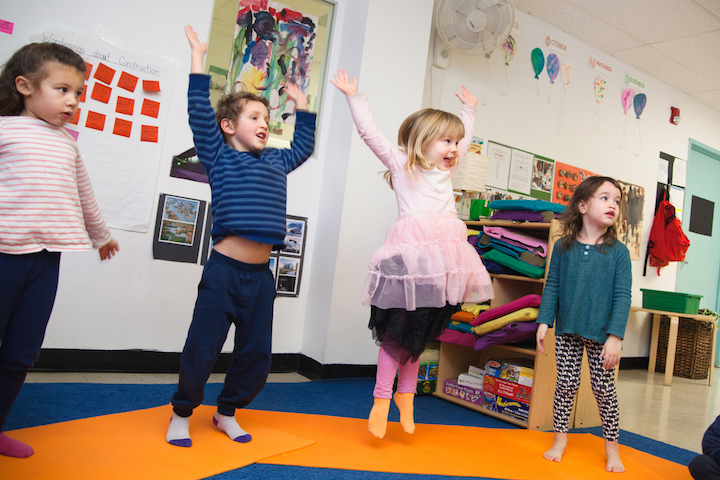5 Dalcroze-Inspired Activities to Try with Kids Today
One of the things that sets Yo Re Mi apart from other children’s yoga programs is our use of original music. The songs we write keep our adventures moving in an engaging way.
We have been inspired by a unique musical pedagogy called Dalcroze Eurythmics which informs our process.
What is Dalcroze Eurhythmics?
Dalcroze Eurythmics is a series of movement based activities designed to explore music. Dalcroze Eurhythmics (or simply ‘Dalcroze’), embraces the body as a physical instrument of music, through exercises that create a heightened awareness of the body's responses to music as well as the body in physical space. At Yo Re Mi, we use Dalcroze to explore these musical concepts:
rhythm (the beat and the pattern of notes aligned to the beat)
tempo (the speed of the rhythm)
pitch (quality of sound as relates to it’s frequency, on a range of high-to-low)
tone (the shape of the sound)
volume (the loudness of the sound)
Here are 5 Yo Re Mi activities inspired by Dalcroze Eurythmics
1. Sun Dance
The Sun Dance is one of the earliest Yo Re Mi songs to incorporate Dalcroze Eurhythmics. Using the Sun Salutation as a basis for the movement, our Sun Dance song accentuates the upward and downward movement of the body with ascending and descending musical phrases. Essentially, the body and music move up together, and down together.
Try This: The Sun Dance (video)
The Dalcroze Method was developed beginning in 1886 by Emil Jaques-Dalcroze, a Swiss composer and teacher. He wrote:
“I am beginning to think of a musical education in which the body would play the role of intermediary between sound and thought, so becoming an expressive instrument. Bodily movement is an experience felt by a sixth sense, the muscular sense. This consists of the relationship between the dynamics of movement and the position of the body in space, between the duration of movement and its extent, between the preparation of a movement and its performance.”
2. Four-beat Pattern
Dalcroze Eurythmics physicalize rhythm. When the body moves with the beat, it reinforces an experience of hearing the beat, and imprinting the experience on the muscular system.
Yes, it’s is possible to teach a 4-beat pattern as a concept — but it’s much easier to understand when it moves. It’s visual and kinesthetic, which includes more learners than just those who “understand” the concepts intellectually.
Try This: 4 beat pattern (video)
In the quote above, Dalcroze mentions “The position of the body in space.”
That concept is what we now call “proprioception” — and this important awareness is what many in the neurosciences call “the sixth sense,” just as Dalcroze did.
Dalcroze was many years ahead of his time in noticing the importance of physical awareness in brain development, and how musical awareness could be enhanced by incorporating physical movement. It is crucial to nurture our mind-body connection from a young age, which is why Yo Re Mi combines music and movement into our multi-faceted activities.
3. Hop A Lot, Stop
Simply by hearing and responding to music, children will experience focused listening and body awareness.
Jumping reinforces the beat, while varying the tempo can make it an even more dynamic activity. It is not unusual for pre-schoolers to request “Hop A Lot, Stop!” every day, or multiple times per day. And while its simplicity may provide cover, this activity actually has many systems working at once!
Try This: Hop A Lot, Stop! (video)
As Dalcroze has become a tried and true pedagogy among music educators, one style component stands out: it is a playful approach.
Children moving to music can be wholly enjoyable, completely free, without judgment. As educators and supporters of mindfulness, non-judgement, and play-based learning, there is no better complement than Dalcroze. That’s why Yo Re Mi creates so many Dalcroze-Inspired activities.
4. Helicopter
As Shelley’s arms move back and forth rhythmically, setting the beat of the activity, the body is getting a terrific torso stretch, which can aid in breathing as well as digestion.
Notice what changes when Shelley modifies the speed of the movement?
The pitch also changes: higher for faster, and lower for slower! As we slow down to the end, we roll shoulders rhythmically, for a release of serotonin and to gain additional body awareness. So much is working together here.
Try This: Helicopter (video)
As we explore these activities in a non-judgmental environment, each participant gets to have an individual, unique experience. This reinforces important concepts of self-acceptance and confidence, discernment as well as compassion and understanding.
If two children are making different helicopter sounds, they are each exploring sounds joyfully, and neither is right or wrong. The child who is not yet making helicopter sounds may be thinking or developing those sounds internally, or having another entirely valuable experience.
What Dalcroze models for educators, families and children is powerful - there is no correct way of being, of listening, of speaking or singing. There just is.
5. Fire Fighter
This activity came alive in a classroom of two year olds. By incorporating the eight-note major scale, we found a framework to create a movement sequence around the children’s fascination with fire stations and the heroes who work there.
Each step is a different movement, and we add one movement and note per round. The children are focused on each step in the process, taking cues from the bells, and trying to remember the sequence as it gets longer. Patterning and sequencing is a natural part of musical education.
Try This: Fire Fighter (Video)
In “Fire Fighter,” we’re taking it to another level. Usually, songs and activities for young children are fairly short, as they tend to focus in bursts and not long durations.
We were astonished to notice a majority of 2- and 3-year olds were participating in this activity from start to finish! Another example where the combination of musical concepts and interesting movements leads to high engagement.
Further learning...
These five activities are just a few of the many Yo Re Mi activities which incorporate the important Dalcroze music pedagogy. As you explore our activities on the app or YouTube, you may start to see things how we do — that each moment which combines music and movement lifts the experience to a new and unique height.
Reinforcing musical concepts with movement is a powerful teaching approach — one that every Yo Re Mi teacher learns about in our teacher trainings and workshops.
Let us know how Yo Re Mi’s incorporation of Dalcroze is helping you!
Save this article for later and don’t forget to download the Yo Re Mi app for ad-free kids musical yoga and mindfulness videos.





